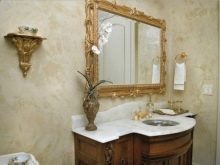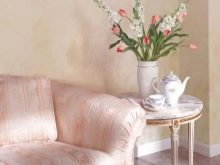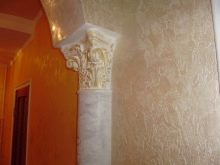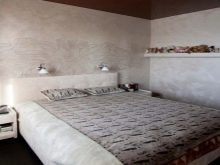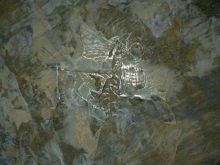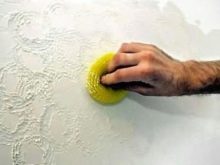Wax for decorative plaster: composition recipes and application features
The wax serves as a coating for decorative plaster and is the final touch in creating a complete picture. In order for the wall, finished with plaster, to have a complete look, it is necessary to apply wax on it. It differs in the composition and characteristics of the application. The waxed surface does not tarnish over time. The protective wax layer does not allow paints to lose their original color, they remain as juicy after many years.
And not only in this benefits of wax. It is able to protect walls from moisture, but at the same time it lets in air, thanks to which the walls breathe, mold and fungus will not appear on them. That is, any of the most elegant repairs, for which considerable funds have been spent, will delight its owners for many years.But, of course, the application of wax is directly interrelated with the application of plaster, and with the preparation of walls or ceilings. In order for everything to be beautiful and functional, the technologies of all processes must be observed. There will be no proper effect if at least one link failed in this important chain.
Some are afraid to apply the composition on their own, considering it a difficult process. In fact, it is quite a feasible task, if you do everything according to the instructions and choose the right wax. You can even do it yourself, using a proven recipe, as well as achieve the desired shade with additional components.
Variety of coatings
Today, without much difficulty in building supermarkets, you can choose exactly the wax that fits to a specific surface, read the instructions for applying and get advice from the seller.
When making Venetian plaster wax acts as a protector from moisturewhich creates a thin film. In addition, the wall treated with such wax looks elegant and gets extra shine.
There are two options for choosing wax in this case. It is liquid or in the form of a gel.The glossy surface can be simply coated with liquid wax. The porous surface is suitable gel wax.
Wax may contain substances with natural or synthetic ingredients. Beeswax is a natural product, thanks to which you can create a thin layer on the wall, thereby making it shine.
If the gloss does not matter, you can use the composition, made by artificial means based on synthetic materials. It tends to give the wall dullness, but it is considered that this coating is much safer and will last longer.
Each wax variant has water in its base. Based on this, you can slightly adjust the composition purchased in the store. If it looks excessively thick, it can be slightly heated, but not on an open fire, but simply placed near a warm place, for example, near a battery. When it melts, you can add water. Its quantity should not exceed three percent. Then the composition is recommended to leave for three days, so that the mass becomes uniform. After that you can start the finishing work.
We select for a different surface
It is impossible to consider the wax coating separately from the type of plaster, because it is the logical conclusion of the work that began with the choice of plaster and wall covering. Gypsum plaster requires one coating option, for Moroccan or Venetian - another.
It is necessary to dwell on several types of decorative plasters, especially popular today, and variants of their coating.
The variety of decorative plasters and wax will allow you to think about the style of the room to the smallest detail. and create a coating so that it matches its performance. For example, provided that the plaster will be treated with wax or varnish, it is possible to decorate with its help both the bathroom and the bathroom and the kitchen.
If the choice fell on Venetian plaster, then the coating in the room will have a glossy smooth structure, the pattern will be translucent. All this will be possible thanks to the technique of applying multiple layers. As a result, imitation of marble, granite, jasper can be achieved.
Venetian plaster is applied in several layers. Thanks to such “stone” walls, the effect will be simply amazing.The wax will complement the composition, thanks to him reflections and play will appear on the wall. Plaster and wax coating together will create not only the original design, but also strength. Such coverage over the years will not crack and will not fade and will last at least 15 years. In addition, after the final drying it can be safely washed without fear of spoiling something. After all, wax creates a protective film for such an expensive coating.
There is another option to achieve the effect of antiquity - with the help of a special varnish, after which the cracks on the wall will crack. But this is only a visual effect. The strength and quality of the coating will not suffer from this.
There is Venetian plaster, which already contains wax, and such a coating due to its waterproofness can be used even in bathrooms.
Venetian plaster is often preferred to be treated with transparent wax, since the color of the plaster itself is usually thought out to the point that it does not require an additional shade. Exceptions are only those cases where, in addition to brilliance, you need to achieve more and the ebb of gold or silver.This effect is easily achieved by adding special components.
For other types of plaster, you can use color wax, which allows you to create a variety of shades on the wall. This option is suitable for Moroccan plaster.
Its composition contains wax and linseed oil, which also creates a water-repellent effect. Preparatory and relief layer create unique patterns on the wall. The top protective layer, the application of which is necessary at the final stage, is applied with wax. And his presence is required. Therefore, experts recommend to buy the finished product to ensure that the coating turned out exactly as it should be. Then for a long time of operation there will be a guarantee that the plaster will not be subject to destruction and deformation. At the last stage, gold leaf can be added to the wax to get the effect of the vein. Moroccan plaster is just the case when you can, if you wish, treat the areas with colored wax in order to enhance the effect, to give the paints depth and saturation.
How to apply?
To the wall had a uniform shade without transitions, the work can not be interrupted.Then the wall will have a uniform structure and color. If it can be difficult for one not quite an experienced master, then the two of them will be much easier to handle.
When buying wax, it is recommended to calculate in advance the area to be covered. Consumption can be different, but it depends on the composition of wax and plaster, which was processed wall, as well as the final effect, which is to be achieved.
After all the layers of plaster are applied to the wall and they have dried out well, you need to prepare the surface for the waxing procedure. It is necessary to once again carefully examine the entire area for any previously unnoticed flaws. After applying the wax to fix them will be very problematic. The wall should be dust free. If it was previously wiped with a damp cloth, you need to give it some time to dry.
When applying wax the surface must be completely dry and clean.
The most basic is accuracy and no hurry.
Professionals usually apply wax with a trowel, you can also use a rubber trowel. Beginners will be easier if you take a small amount of wax and treat small surfaces.So more likely to avoid defects, because the wax dries quickly and if you do not act quickly enough, the surface may be uneven. The wax is rubbed on the surface with a clean white soft cloth, preferably with flannel, until the wall begins to shine.
The drying time of the wax depends on which company it is produced. Some manufacturers promise that the wax will dry within three hours, others have a figure of six on the packages. But in any case, complete solidification will occur in a period of two to three weeks. After that, the walls will not be dangerous to handle with a damp cloth and use detergents non-aggressive effects.
Wax has unlimited possibilities. - this final chord will add zest to your room. The main thing is to master the technique of its application. If necessary, you can create a relief on the surface or experiment with different colors. But just do not do this. There should be a clear idea of how it will look in reality. And it does not interfere with a pre-thought sketch. This will avoid unnecessary frustration.Even better, if you start with a small wall and not central, but unobtrusive. This will allow you to get the first experience and take into account errors when continuing to repair on more visible surfaces.
Error correction
If after the completion of the work any flaws were found on the wall, then it is not too late to fix them right away. But after four hours it will be difficult to do. Therefore, it is better to hurry. Excess well cleaned with a clean cloth. If not, you can slightly moisten it in white spirit and wipe the surface.
It also happens that the composition is completely hardened, and only then some flaw rushed into the eyes. Do not panic. In some cases, a construction hairdryer can help. With it, heats the area where the defect is found. Then the coating is washed off with hot water. You can try to process the spoiled piece with a special solvent that removes the primer from the wooden surface.
It is necessary to take into account the fact that after all the manipulations this area may look different than the whole wall.
Therefore, it is better to eliminate all errors at once, as they say, “without delay”. Better yet, avoid them.
Make it not so difficult. When working with wax, do not take too much on the trowel or spatula. It is better to take a little, rub it well, work gradually in small areas, moving gradually in one direction. Then the coating will lay a uniform layer.
According to the masters who have experience in applying plaster and wax, there are such types of coating, which after a few days nothing can be fixed and you don’t even have to try to make it even worse. We are talking about wax, which includes acrylic component. It cannot be melted with hot air and washed off with any chemicals. The film is very durable. This is a very good and high-quality wax, but, most likely, it is better to use it if you have confidence in your abilities and at least a little experience with plaster.
Wax is the final stage, due to which it is possible to achieve brilliance and an interesting effect on the surface. But sometimes it happens that the color of the applied plaster in reality differs from that which was originally conceived. This often happens to those who work with this type of material for the first time.Redoing the wall is difficult and troublesome, and it is expensive, considering that decorative plaster does not have a low cost. There is a chance to fix everything with wax. You can buy yellow, which will give the effect of light gilding. If you add silver in a colorless wax, you can achieve on the surface of a silvery shade.
In most cases, applied when covering the walls of transparent wax or yellow. There are also colors that allow you to tint yourself.
For decoration of textured plaster, compositions containing pearlescent, gold or silver components are often chosen. Colored wax is more suitable if you want to create a Moroccan interior or an imitation of natural stone.
How to make yourself?
You can also use homemade wax, but for a start it is recommended to check on some surface what happened before applying it on the wall as a final design.
The basis will be glue for non-woven wallpaper. It must be diluted according to the instructions, very well stirred using a construction mixer or a special nozzle for a drill. If there is neither one nor the other, an ordinary mixer will do.There should be a homogeneous mass without a single lump. Then the panel glossy varnish is added, all this is thoroughly mixed. If it is planned that the wax should have a shade, at the end paint is added with the effect of gold or silver.
You can go the other way. The basis of the wax will be a transparent wax purchased from a store, and silver, bronze or golden fine powder will be suitable as an additional component. This composition will give the wall gloss and ebb - bronze, silver or gold, depending on the selected component.
Cost and quality
The price of wax depends on the manufacturer and the materials (natural or synthetic) from which it is made. To get an idea of how much wax you might need, you can take as a basis the average figure, which ranges from 50 to 70 grams per square meter. The price of the coating for decorative plaster varies from four hundred to four thousand rubles.
For example, a kilogram of WGT wax produced in Russia can be bought for 440 rubles., the same volume for Venetian plaster is only ten rubles more expensive.This type of coating is made using synthetic materials. With natural ingredients, the mixture is significantly more expensive. Coverage "Cera di Veneziano" (Russia) will cost 3900 rubles per liter. That is the amount in the package. Color wax from Sweden from Parade will cost from 700 to 800 rubles.
The choice, of course, for the consumer. But the masters strongly recommend not to save on the purchase of wax, at least for the reason that if initially the differences can not be seen, it is not known how the wax will behave after several years of operation and how the surface will look like.
This primarily applies to Venetian plaster, where wax is considered one of the most important components. Whether the top layer will protect the wall and delight with gloss and gloss depends on the finishing work that is done with wax. And one more plus in favor of natural wax - only about this product can we say with certainty that it is one hundred percent non-toxic. In addition, high-quality wax is more pleasant to work with, it is better placed and distributed over the surface. And that means working with him is a pleasure.
One of the leaders in the number of sales and the quality of the products offered in this area is considered the Italian company Cebos-Ecocera.The content in this coating of white beeswax ensures long-term reliable protection of the surface and bright gloss, which certainly will please with its colors and modulations.
What to replace?
It is impossible to do without the final processing of the plaster with wax, because it will not receive the finished look that it was planned to give it. But in some cases, when, for example, there is not enough skill in applying wax or it was not possible to buy the desired option, there is an alternative. Varnish performs the same functions as wax. It protects the surface from harmful effects, retains the paint for a long time, adds shine.
A few days after varnishing, you can safely wash the surface with a damp cloth without fear of damaging the coating.
Lacquers also have their own classification. For decorative plaster are those that have a safe composition for humans and dissolve in water. Varnish may be more matte or glossy, it may vary in drying time.
The main thing that you need to pay attention to when choosing this or that composition is that it is breathable and at the same time moisture-resistant. These characteristics are the most important.
Usually, acrylic lacquer, which has a water base, is chosen for the treatment of decorative plaster. It has no smell, it is non-toxic and is considered an environmentally friendly material.
When dried, white liquid turns into a protective transparent layer, which gives the wall a glossy shine and does not change colors at all. Sometimes this solution is tinted if there is a need not only to give the surface a gloss, but also to add shade.
Dries lacquer usually very quickly. Three hours are enough for complete drying. In addition, varnish is used when you need to give the surface the effect of antiquity and make cracks. In such cases pearl lacquer is usually used. It gives a silvery or golden play.
Applying varnish on the wall - the process is not complicated, but even pleasant. But you need to take into account some points that will facilitate the work and improve the quality of the final coating. Before applying the varnish on the plastered surface, it must be treated with a primer. It will further protect the surface from mold and mildew, strengthen the plaster and reduce the consumption of varnish. It is applied in several ways: using a spray or using a brush, roller, sponge.
As for varnish, it is easier to correct mistakes with it than with wax.It is enough to remove the old layer with a special solution and apply a new one.
Reviews
Before making this or that work, you can use the reviews of professional masters or those who decided to make repairs using for the first time such coatings as decorative plaster and wax.
As noted by many, the advantages of wax for plaster are obvious. The coatings they treated look gorgeous and elegant. Any room can be changed beyond recognition. Thanks to the correctly chosen colors and textures, the design of the room looks harmonious.
Housewives focus on the fact that surfaces treated with wax in compliance with all technological processes do not deteriorate over time even under the influence of moisture. And very important is the fact that they are easy to care for.
A number of consumers mark the moment that both plaster and wax are expensive materials that should last for a long time. Therefore, it is necessary to treat them very carefully.
It is necessary to take into account the moment that if any separate fragment is damaged, it will be impossible to restore the original version. During restoration, the shade will necessarily differ from the general.Sometimes shades are selected so carefully that then to achieve exactly the same tone is simply unrealistic. Even the best master cannot do this. There is only one option in this case - to change the entire coverage.
The conclusion can be made one: when choosing decorative plaster it is worthwhile to think at once what wax will be used as a topcoat and purchase all the necessary materials and tools.
How to apply wax on decorative plaster, see the next video.
















